
The peony or paeony is a flowering plant in the genus Paeonia, the only genus in the family Paeoniaceae. Peonies are native to Asia, Europe and Western North America. Scientists differ on the number of species that can be distinguished, ranging from 25 to 40, although the current consensus is 33 known species. The relationships between the species need to be further clarified.

Paeonia rockii, or Rock's peony, is a woody species of tree peony that was named after Joseph Rock. It is one of several species given the vernacular name tree peony, and is native to the mountains of Gansu and adjoining provinces in China. In Chinese, it is known as 紫斑牡丹.

Paeonia lactiflora is a species of herbaceous perennial flowering plant in the family Paeoniaceae, native to central and eastern Asia from eastern Tibet across northern China to eastern Siberia.

Paeonia brownii is a low to medium height, herbaceous perennial flowering plant in the family Paeoniaceae. It has compound, steely-gray, somewhat fleshy leaves and small drooping maroon flowers. Its vernacular name is Brown's peony, native peony or western peony. It is native to the western United States and usually grows at altitude, often as undergrowth in part-shade. The fleshy roots store food to carry the plant through the dry summers and produce new leaves and flowers the following spring.

Paeonia californica is a perennial herbaceous plant of 35–70 cm high, that retreats underground in summer, and reoccurs with the arrival of the winter rains. It has lobed leaves, elliptic (cup-shaped) drooping flowers with dark maroon-colored petals, and many yellow anthers. It flowers mostly from January to March, and later develops two to five fruits per flower. Its common name is California peony and it is sometimes also referred to as wild peony. This peony is an endemic of southwestern California (USA), where it is not rare, and northernmost Baja California (Mexico). It grows on dry hillsides in the coastal sage scrub and chaparral communities of the coastal mountains of Southern and Central California, often as an understory plant.
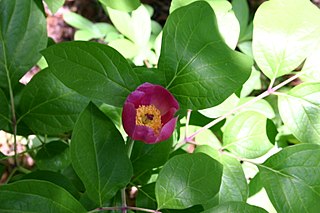
Paeonia obovata is a perennial herbaceous species of peony of 30–70 cm high. It has white to purple-red flowers and its lower leaves consist of no more than nine leaflets or segments. In China the vernacular name of the typical subspecies is 草芍药, meaning "grass peony", while ssp. willmottiae is known as 拟草芍药, "false grass peony". In Russia this species is called Пион обратно-овальный, or "inverted egg-shaped peony". In Japanese, it is known as ヤマシャクヤク (yamashakuyaku), meaning "mountain peony". In English it is sometimes called woodland peony. It grows naturally in warm-temperate to cold China, including Manchuria, and in Korea, Japan, Far Eastern Russia and on Sakhalin.
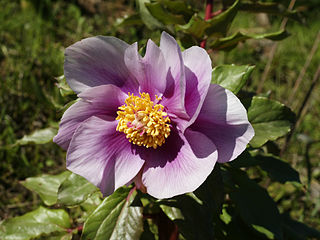
Paeonia mascula is a species of peony. It is a herbaceous perennial 0.5–1.5 m (1.6–4.9 ft) tall, with leaves that are divided into three segments, and large red flowers in late spring and early summer. Native to Syria, Spain, France, Italy, Croatia, Bosnia and Herzegovina, Serbia, Montenegro, Bulgaria Greece, Turkey, Iraq, Lebanon and Israel, this wild peony has become naturalised on two small islands in the UK.
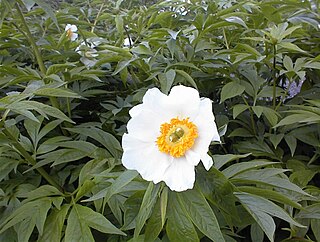
Paeonia emodi is a robust herbaceous perennial plant that winters with buds underground, has large white flowers and large deeply incised leaves, and belongs to the family Paeoniaceae. Its local vernacular names include mamekhor or mamekh (Punjabi), ood-e-saleeb (Urdu) meaning "with-a-cross", ood salap (Hindi), mid and 多花芍药 meaning "multi-flower peony" (Chinese). In English it is sometimes called Himalayan peony. It is among the tallest of the herbaceous peony species, and, while cold-hardy, it grows better in warm temperate climates. It is a parent of the popular hybrid 'White Innocence', which reaches 1½ m.
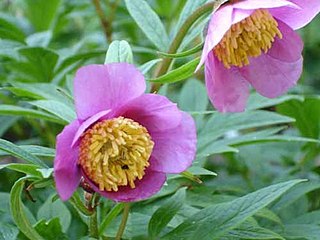
Paeonia veitchii is a species of herbaceous perennial peony. The vernacular name in China is 川赤芍. This species is ½-1 m high, has a thick irregular taproot and thin side roots, and deeply incised leaves, with leaflets themselves divided in fine segments. It has two to four fully developed flowers per stem, that may be pink to magenta-red or rarely almost white. It is known from central China.

Paeonia delavayi is a low woody shrub belonging to the peonies, that is endemic to China. The vernacular name in China is 滇牡丹, which means "Yunnan peony". In English it is sometimes called Delavay's tree peony. It mostly has red brown to yellow, nodding flowers from mid May to mid June. The light green, delicate looking deciduous leaves consist of many segments, and are alternately arranged on new growth.

Paeonia ludlowii, is a medium high, deciduous shrub, belonging to the peonies, that is endemic to southeast Tibet. In Tibet it is known as lumaidao meaning "God’s flower". The vernacular name in China is 大花黄牡丹 meaning "big yellow-flowered peony". In English it is sometimes called Tibetan tree peony or Ludlow's tree peony. It has pure yellow, slightly nodding, bowl-shaped flowers, and large, twice compounded, light green leaves.

Paeonia × suffruticosa is a name used for a group of cultivars of tree peonies that are the result of hybridisation with species exclusively belonging to the subsection Vaginatae. The common name used in China is mǔdān. Plants belonging to this group have been cultivated for millennia in China, initially only as a source of traditional Chinese medicine particularly the skin of its roots. Already early on the plant was also cultivated for its ornamental value, and it is highly revered in Chinese culture.
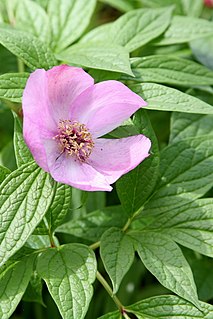
Paeonia mairei is a species of peony, that is endemic to the mountains of central China. Its vernacular name in China is 美丽芍药 meaning "beautiful peony". The plant may be between 45–100 cm high and has mostly rose-pink flowers of about 10 cm across, one on each stem. P. mairei blooms in early spring.
Paeonia sterniana is a perennial, herbaceous peony of approximately 45 cm high in cultivation, with white or sometimes pinkish flowers. It grows in the wild in southeastern Tibet. This peony is very rare in cultivation. It produces blue seeds in autumn. Its common name in Chinese is 白花芍药, which means "white peony".

Paeonia tenuifolia is a herbaceous species of peony that is called пион тонколистный in Russian, and nazikyarpaq pion in Azeri, both meaning "thin-leaved peony". In Ukraine it is known as півонія вузьколиста, which means "narrow-leaved peony", or степова півонія "steppe peony", while the Bulgarian/Serbian vernacular names теснолист божур /усколисни божур, тънкостен божур /танколисни божур and степен божур/степски божур, have the same meanings. In English it is sometimes called the fern leaf peony. It is native to the Caucasus Mountains of Russia and the Black Sea coast of Ukraine, spreading westward into Bulgaria, Romania and Serbia and eastward to northwestern Kazakhstan. It was described by Linnaeus in 1759. The leaves are finely divided into almost thread-like segments and grow close together on the stems. This peony can reach between 30 and 60 centimeters in height. The flowers are red and scented with numerous yellow stamens in the centre.
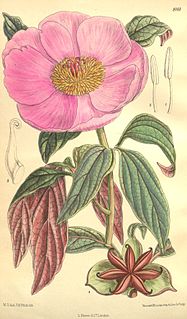
Paeonia cambessedesii is a perennial herbaceous species of peony about 45 cm high. It has pink flowers. The stems, major veins and undersides of the leaves remain purple red, while the upper surface of the leaves turns into a metallic bluish green when fully grown and its lower leaves consist of no more than nine leaflets or segments. This endemic of the Balearic Islands is now limited to parts of northeastern and northwestern Majorca. In English it is sometimes called Balearic peony or Majorcan peony.
Paeonia parnassica, the Greek peony, is a plant that is native to the mountains of south-central Greece. The flowers are produced in late spring with a deep maroon red colouring on 65 cm stems. The blooms are large, up to 12 cm in diameter and bear a boss of rich orange stamens. This peony was once included with the species P. mascula.

Paeonia anomala is a species of herbaceous perennial peony. The vernacular name in Russia is Пион необыча́йный meaning "anomalous peony", in Kazakh it is called кәдімгі Таушымылдық "common peony", in Mongolia Ягаан цээнэ "pink peony", and in China 新疆芍药, "Xinjiang peony". These plants are ½-1 m high, have a thick irregular taproot and thin side roots, and deeply incised leaves, with leaflets themselves divided in fine segments. It has almost always only one fully developed flower per stem, magenta-red or rarely pink or white. The species occurs in a zone between northern European Russia and northern Mongolia and south to the Tien Shan Mountains. P. anomala bears flowers in early summer.
Paeonia kesrouanensis is a species of peony native to Syria, Turkey and Lebanon. It is very similar to P. mascula, bearing rose-red flowers.
Paeonia qiui is a species of peony very similar to P. jishanensis, but with more divided foliage. It can reach up to 1.2m in height. Identification characteristics: petals with a red blotch at base; leaflets mostly entire, often purple above; flowers single.















